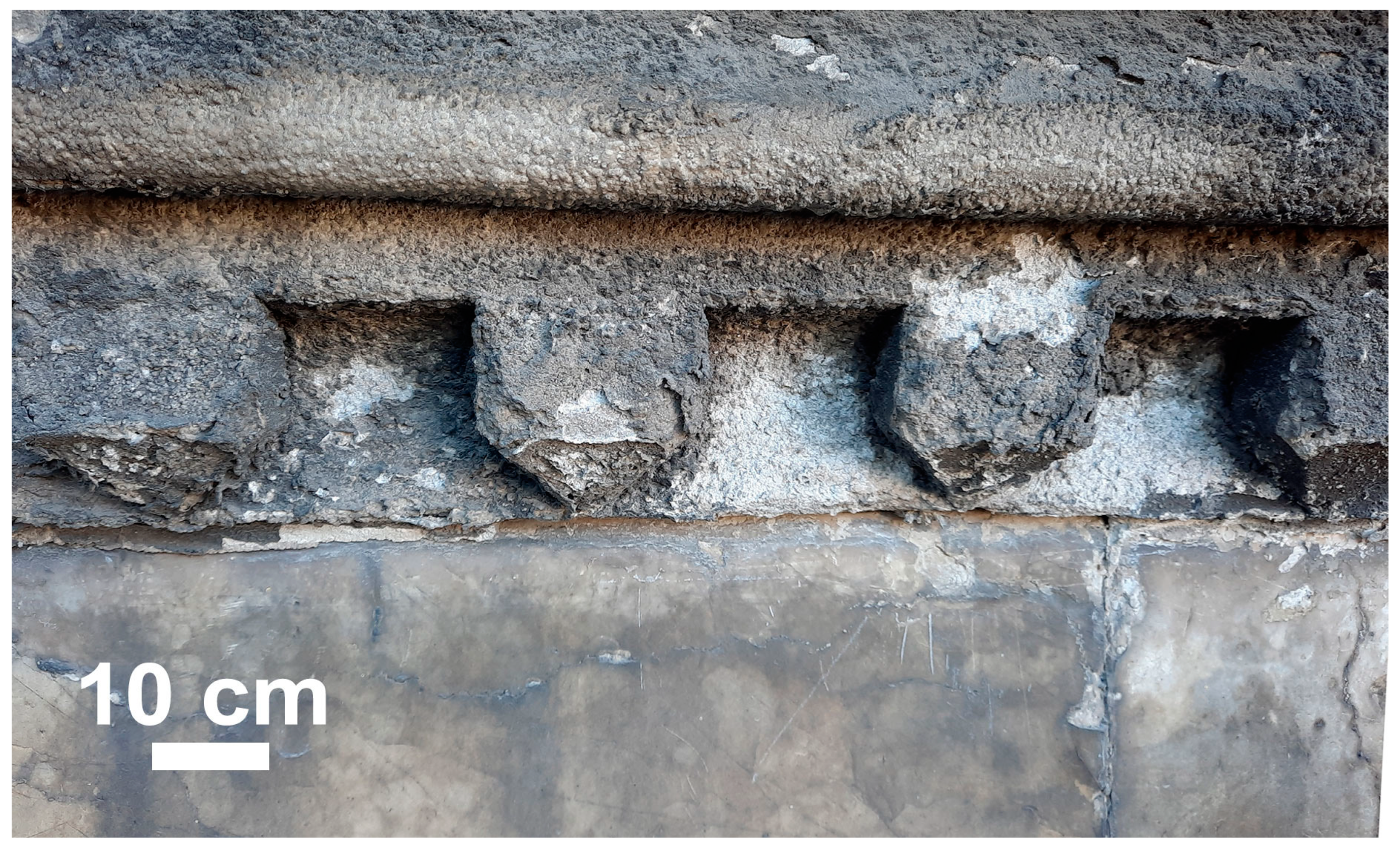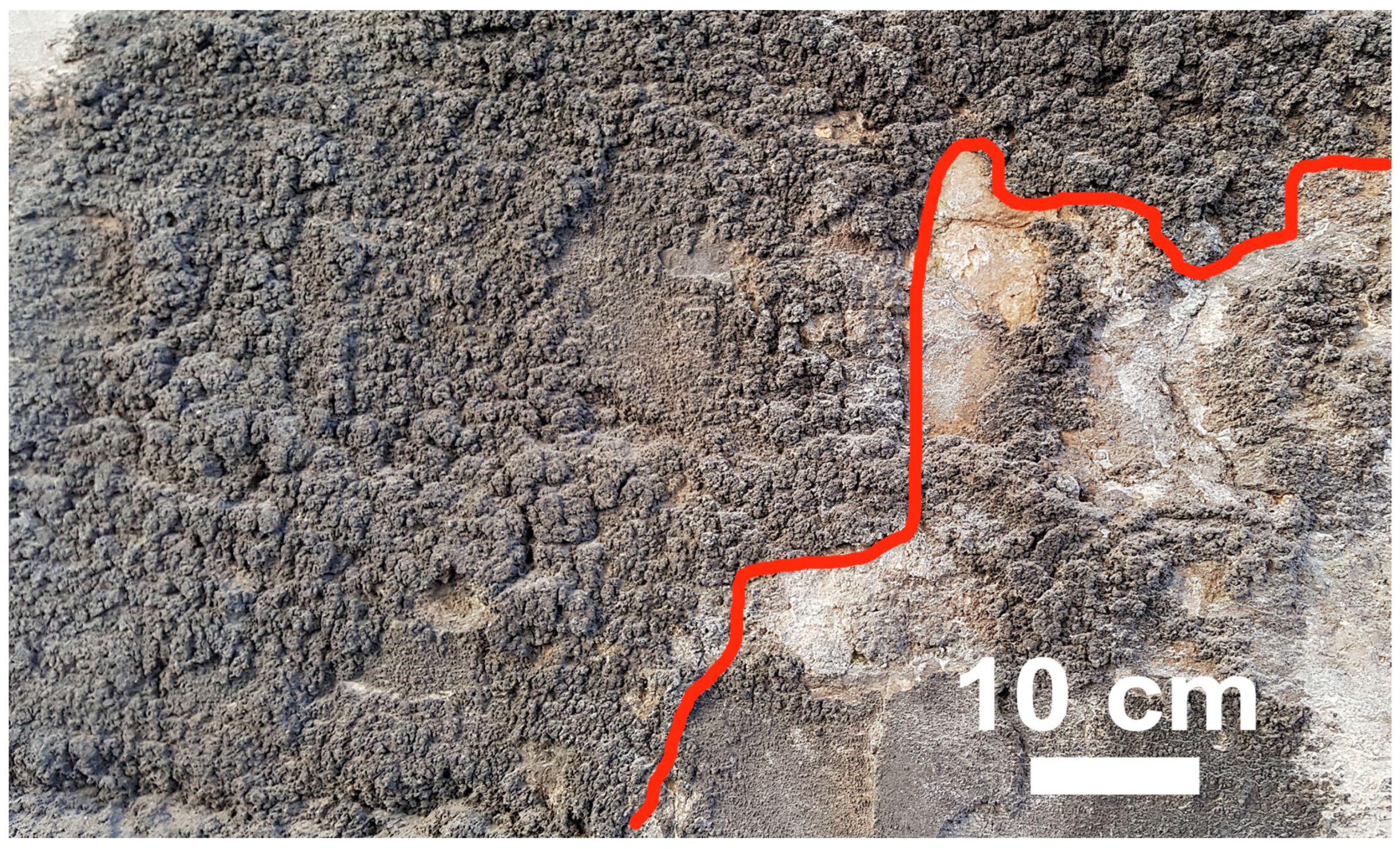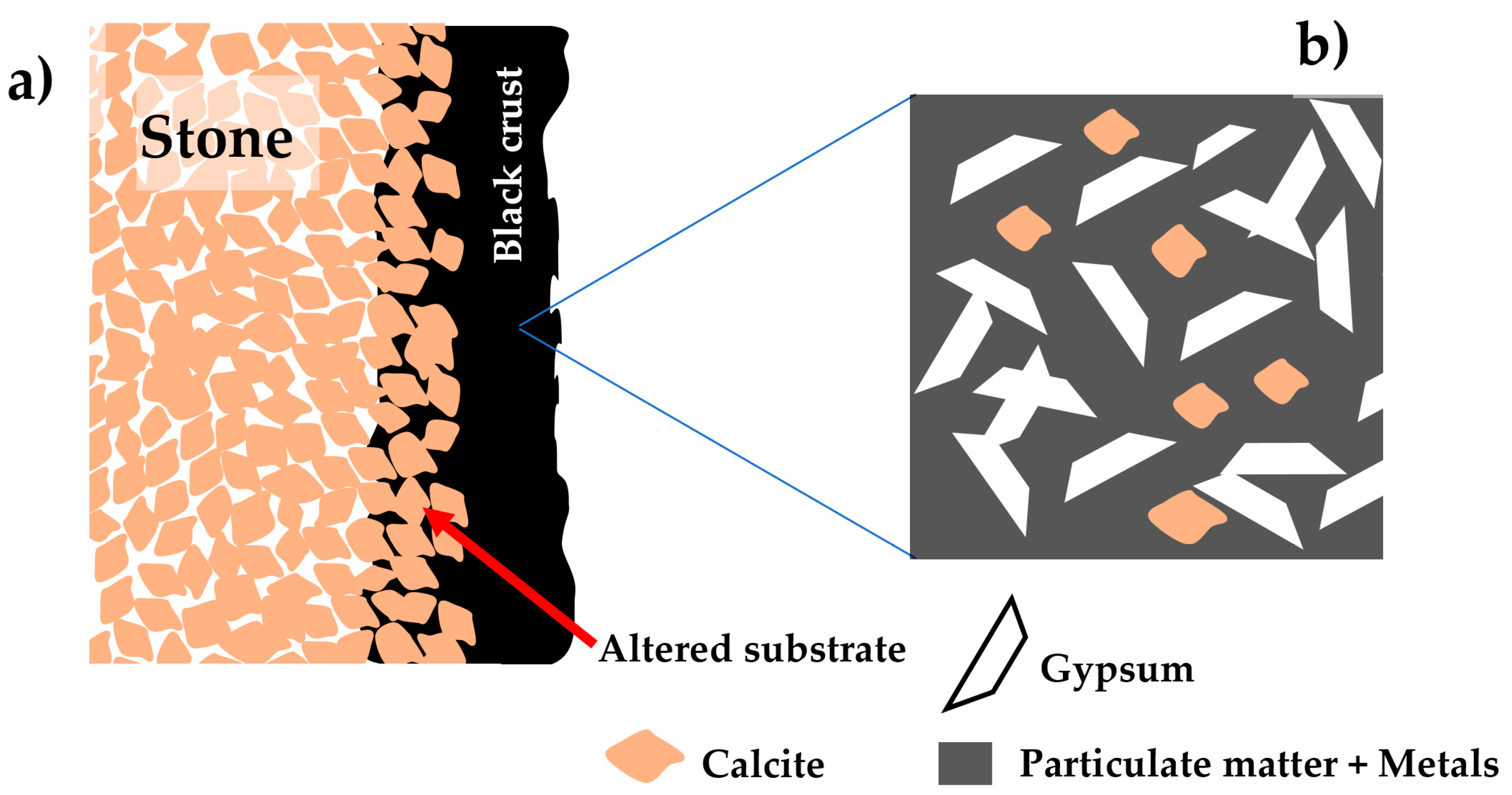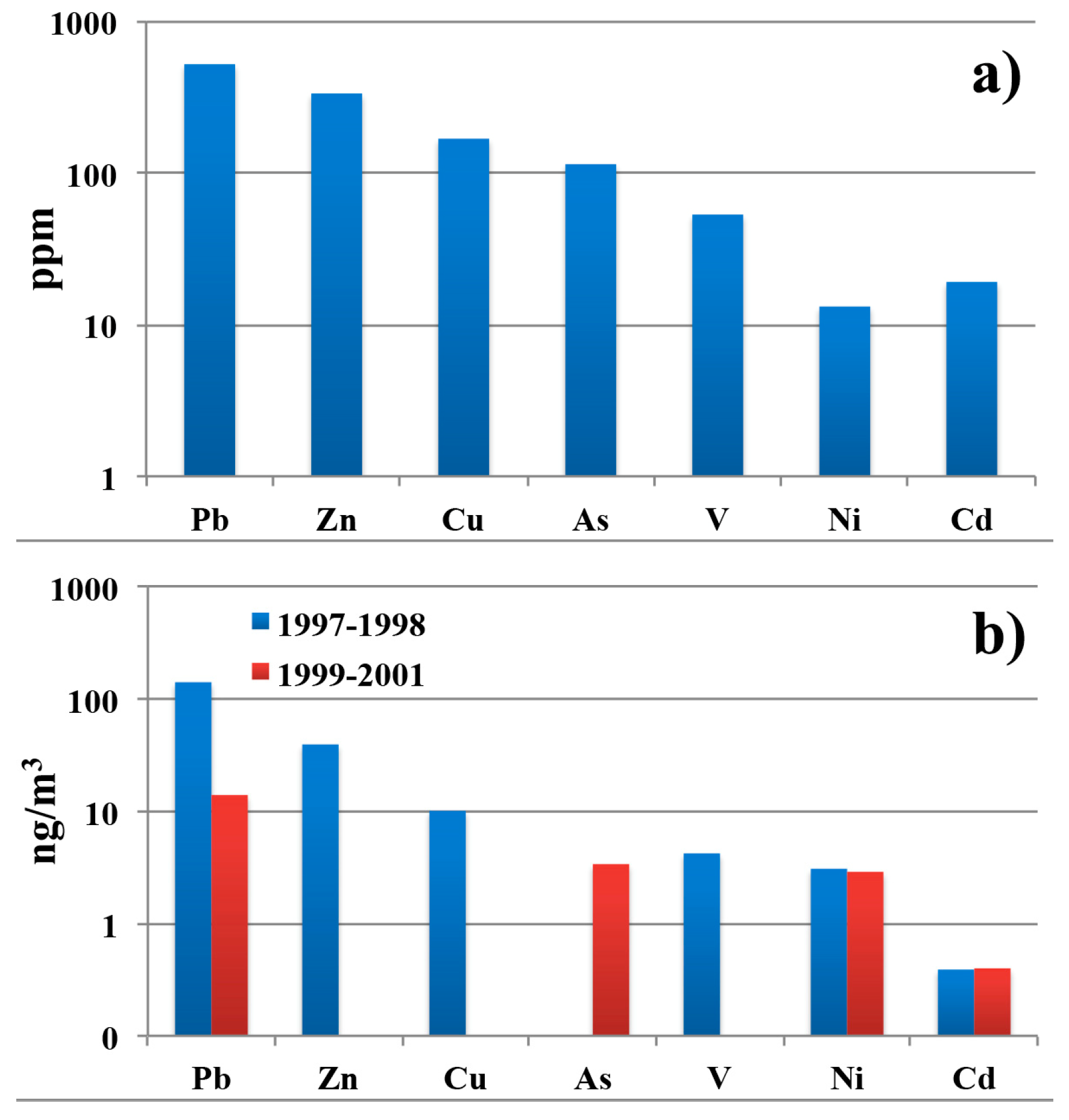The Impact of Air Pollution on Stone Materials
Abstract
:1. Introduction
2. Air Pollution and Stone
3. The Study of Black Crusts
3.1. The Sampling Methodology
3.2. Structure and Main Components
3.3. Analysis of Metals
| Sampling | Country | As | Ba | Cd | Cr | Cu | Mn | Ni | Pb | Sb | Sn | V | Zn | Ref |
|---|---|---|---|---|---|---|---|---|---|---|---|---|---|---|
| Tower of London | England | 57.2 | 4.4 | 41.2 | 185.6 | 275.0 | 56.5 | 807.6 | 20.2 | 38.2 | 116.8 | 384.1 | [52] | |
| Mechelen Cathedral | Belgium | 35.6 | 0.2 | 58.6 | 182.2 | 120.9 | 29.7 | 1721.3 | 10.1 | 9.7 | 320.2 | 3436.8 | [53] | |
| St. Eustache Paris | France | 58.1 | 12.2 | 15.0 | 89.4 | 68.4 | 33.2 | 813.3 | 17.0 | 165.7 | 66.8 | 451.8 | [53] | |
| Seville Cathedral | Spain | 85.5 | 15.3 | 213.7 | 125.1 | 255.0 | 18.4 | 378.2 | 8.7 | 819.3 | 43.5 | 226.7 | [54] | |
| La Galea Fortress, Getxo, Basque Country | Spain | 16.3 | 110.7 | 0.3 | 20.3 | 19.0 | 74.0 | 10.0 | 299.3 | 2.0 | 6.7 | 19.0 | 184.7 | [21] |
| Altenberg Cathedral | Germany | 28.0 | 890.0 | 12.0 | [45] | |||||||||
| Cologne Cathedral | Germany | 365.0 | 1849.0 | 37.0 | [45] | |||||||||
| Xanten Cathedral | Germany | 50.0 | 1944.0 | 16.0 | [45] | |||||||||
| Corner Palace in Venice | Italy | 125.4 | 4.2 | 54.2 | 98.3 | 327.9 | 49.5 | 2613.1 | 41.7 | 31.1 | 106.4 | 712.5 | [53] | |
| Fontana di Trevi Rome | Italy | 58.2 | 620.3 | 49.3 | 122.8 | 26.8 | 557.3 | 34.0 | 45.4 | 103.9 | 337.0 | [62] | ||
| Monza Cathedral | Italy | 240.0 | 2415.5 | 72.0 | 2567.5 | 217.0 | 221.0 | 9009.0 | 399.5 | 546.5 | 302.5 | 2047.0 | [31] | |
| Historical center of Naples | Italy | 21.5 | 532.2 | 0.9 | 16.4 | 89.8 | 7.9 | 1395.1 | 9.6 | 22.9 | 628.0 | [34] | ||
| Historical center of Venice | Italy | 170.2 | 836.2 | 8.1 | 65.2 | 160.8 | 179.9 | 696.5 | 40.7 | 604.0 | 98.6 | 1848.2 | [35] | |
| St. Cosimato Cloister, Rome | Italy | 34.5 | 772.9 | 2.6 | 21.3 | 60.1 | 248.5 | 9.2 | 598.4 | 7.1 | 25.3 | 56.1 | 210.7 | [51] |
| Cemetery Pessago con Bornago (Milan) | Italy | 44.8 | 202.7 | 19.0 | 55.1 | 64.6 | 250.1 | 13.0 | 2821.2 | 62.0 | 222.7 | 123.5 | 414.2 | [51] |
| Renaissance city walls of Padua | Italy | 47.8 | 8.7 | 68.9 | 489.8 | 46.4 | 6738.2 | 17.8 | 38.7 | 143.1 | 4171.3 | [44] |
3.4. Particulate Matter and Organic Fraction
4. Intervention Strategies
5. Conclusions
Author Contributions
Funding
Data Availability Statement
Conflicts of Interest
References
- La Russa, M.F.; Ruffolo, S.A. Mortars and plasters—How to characterize mortar and plaster degradation. Archaeol. Anthropol. Sci. 2021, 13, 165. [Google Scholar] [CrossRef]
- Hees, R.P.J.; Binda, L.; Papayianni, I.; Toumbakari, E. Characterisation and damage analysis of old mortars. Mater. Struct. 2004, 37, 644–648. [Google Scholar] [CrossRef]
- Maurenbrecher, P. Water-Shedding Details Improve Masonry Performance; Construction Technology Update 23; Institute for Research in Construction, National research Council: Ottawa, ON, Canada, 1998. [Google Scholar]
- Fassina, V. 46-Influenza dell’inquinamento atmosferico sui processi di degrado dei materiali lapidei. In Bollettino d’Arte “Materiali Lapidei-Problemi Relativi Allo Studio Del Degrado e Conservazione; Ministero per i beni e le attività culturali: Rome, Italy, 1987; pp. 19–47. [Google Scholar]
- Fassina, V.; Favaro, M.; Crivellari, F.; Naccari, A. The stone decay of monuments in relation to atmospheric environment. Ann. Di Chim. 2001, 91, 767–774. [Google Scholar]
- The Early Keeling Curve Scripps CO2 Program. Available online: scrippsco2.ucsd.edu (accessed on 15 March 2023).
- Zeldovich, Y.B. The Oxidation of Nitrogen in Combustion Explosions. Acta Physicochim. USSR 1946, 21, 577–628. [Google Scholar]
- Hegg, D.A.; Hobbs, P.V. Oxidation of sulfur dioxide in aqueous systems with particular reference to the atmosphere. Atmos. Environ. 1967, 12, 241–253. [Google Scholar] [CrossRef]
- Xue, J.; Yuan, Z.; Griffith, S.M.; Yu, X.; Lau, A.K.H.; Yu, J.Z. Sulfate Formation Enhanced by a Cocktail of High NOx, SO2, Particulate Matter, and Droplet pH during Haze-Fog Events in Megacities in China: An Observation-Based Modeling Investigation. Environ. Sci. Technol. 2016, 50, 7325–7334. [Google Scholar] [CrossRef]
- Wang, J.; Li, J.; Ye, J.; Zhao, J.; Wu, Y.; Hu, J.; Liu, D.; Nie, D.; Shen, F.; Huang, X.; et al. Fast sulfate formation from oxidation of SO2 by NO2 and HONO observed in Beijing haze. Nat. Commun. 2020, 11, 2844. [Google Scholar] [CrossRef]
- Wang, P. China’s air pollution policies: Progress and challenges. Curr. Opin. Environ. Sci. Health 2021, 19, 2021. [Google Scholar] [CrossRef]
- Betha, R.; Behera, S.N.; Balasubramanian, R. 2013 Southeast Asian smoke haze: Fractionation of particulate-bound elements and associated health risk. Environ. Sci. Technol. 2014, 48, 4327–4335. [Google Scholar] [CrossRef]
- Particulate Matter|Air & Radiation|US EPA. US Environmental Protection Agency. Available online: http://www.epa.gov/pm/ (accessed on 6 July 2011).
- Amoroso, G.; Fassina, V. Stone Decay and Conservation. Atmospheric Pollution, Cleaning, Consolidation and Protection; Elsevier: New York, NY, USA, 1983; p. 474. [Google Scholar]
- Vergès-Belmin, V. Illustrated Glossary on Stone Deterioration Patterns; ICOMOS: Pairs, France, 2008. [Google Scholar]
- Török, A.; Licha, T.; Simon, K.; Siegesmund, S. Urban and rural limestone weathering; the contribution of dust to black crust formation; examples from Germany and Hungary. Environ. Earth Sci. 2008, 63, 675–693. [Google Scholar] [CrossRef]
- Bonazza, A.; Sabbioni, C.; Ghedini, N.; Hermosin, B.; Jurado, V.; Gonzalez, J.M.; Saiz-Jimenez, C. Did smoke from Kuwait oil well fires affect Iranian archeological heritage? Environ. Sci. Technol. 2007, 41, 2378–2386. [Google Scholar] [CrossRef] [Green Version]
- Antill, S.J.; Viles, H.A. Deciphering the impacts of traffic on stone decay in Oxford: Some preliminary observations from old limestone walls. In Aspects of Stone Weathering, Decay and Conservation; Jones, M.S., Wakefield, R.D., Eds.; Imperial College Press: London, UK, 1999; pp. 28–42. [Google Scholar]
- Török, A. Surface strength and mineralogy of weathering crusts on limestone buildings in Budapest. Build. Environ. 2003, 38, 1185–1192. [Google Scholar] [CrossRef]
- Török, A. Black crusts on travertine: Factors controlling development and stability. Environ. Geol. 2008, 56, 583–597. [Google Scholar] [CrossRef]
- Morillas, H.; Maguregui, M.; García-Florentino, C.; Carrero, J.A.; Salcedo, I.; Madariaga, J.M. The cauliflower-like black crusts on sandstones: A natural passive sampler to evaluate the surrounding environmental pollution. Environ. Res. 2016, 147, 218–232. [Google Scholar] [CrossRef]
- Winkler, E.M. Important agents of weathering for building and monumental stone. Eng. Geol. 1966, 1, 381–400. [Google Scholar] [CrossRef]
- Tartarelli, R.; Davini, P.; Morelli, F.; Corsi, P. Interactions between SO2 and carbonaceous particulates. Atmos. Environ. (1967) 1978, 12, 289–293. [Google Scholar] [CrossRef]
- Spedding, D.J. Sulphur dioxide uptake by limestone. Atmos. Environ. (1967) 1969, 3, 683. [Google Scholar] [CrossRef]
- Braun, R.C.; Wilson, M.J.G. The removal of atmospheric sulphur by building stones. Atmos. Environ. (1967) 1970, 4, 371–378. [Google Scholar] [CrossRef]
- Del Monte, M.; Sabbioni, C.; Vittori, O. Airborne carbon particles and marble deterioration. Atmos. Environ. (1967) 1981, 15, 645–652. [Google Scholar] [CrossRef]
- Wang, M.; Mo, T.; Chen, T. Deterioration of stony cultural relics and their geochemical characteristics. Chin. J. Geochem. 1986, 5, 286–289. [Google Scholar] [CrossRef]
- Del Monte, M.; Vittori, O. Air pollution and stone decay: The case of Venice. Endeavour 1985, 9, 117–122. [Google Scholar] [CrossRef]
- Cheng, R.J.; Castillo, R. A Study of Marble Deterioration an City Hall, Schenectady, New York. J. Air Pollut. Control Assoc. 1984, 34, 15–19. [Google Scholar] [CrossRef]
- Maravelaki-Kalaitzaki, P.; Biscontin, G. Origin, characteristics and morphology of weathering crusts on Istria stone in Venice. Atmos. Environ. 1999, 33, 1699–1709. [Google Scholar] [CrossRef]
- Comite, V.; Pozo-Antonio, J.S.; Cardell, C.; Rivas, T.; Randazzo, L.; La Russa, M.F.; Fermo, P. Environmental impact assessment on the Monza Mathedral (Italy): A multi-analytical approach. Int. J. Conserv. Sci. 2020, 11, 291–304. [Google Scholar]
- Vidorni, G.; Sardella, A.; De Nuntiis, P.; Volpi, F.; Dinoi, A.; Contini, D.; Comite, V.; Vaccaro, C.; Fermo, P.; Bonazza, A. Air pollution impact on carbonate building stones in Italian urban sites. Eur. Phys. J. Plus 2019, 134, 439. [Google Scholar] [CrossRef]
- Rovella, N.; Aly, N.; Comite, V.; Ruffolo, S.A.; Ricca, M.; Fermo, P.; Alvarez de Buergo, M.; La Russa, M.F. A methodological approach to define the state of conservation of the stone materials used in the Cairo historical heritage (Egypt). Archaeol. Anthropol. Sci. 2020, 12, 178. [Google Scholar] [CrossRef]
- Comite, V.; Ricca, M.; Ruffolo, S.A.; Graziano, S.F.; Rovella, N.; Rispoli, C.; Gallo, C.; Randazzo, L.; Barca, D.; Cappelletti, P.; et al. Multidisciplinary approach for evaluating the geochemical degradation of building stone related to pollution sources in the historical center of Naples (Italy). Appl. Sci. 2020, 10, 4241. [Google Scholar] [CrossRef]
- La Russa, M.F.; Comite, V.; Aly, N.; Barca, D.; Fermo, P.; Rovella, N.; Antonelli, F.; Tesser, E.; Aquino, M.; Ruffolo, S.A. Black crusts on Venetian built heritage, investigation on the impact of pollution sources on their composition. Eur. Phys. J. Plus 2018, 133, 370. [Google Scholar] [CrossRef]
- Sabbioni, C. Contribution of atmospheric deposition to the formation of damage layers. Sci. Total Environ. 1995, 167, 49–55. [Google Scholar] [CrossRef]
- Monte, M.D.; Sabbioni, C. Weddellite on Limestone in the Venice Environment. Environ. Sci. Technol. 1983, 17, 518–522. [Google Scholar] [CrossRef]
- Gulotta, D.; Bertoldi, M.; Bortolotto, S.; Fermo, P.; Piazzalunga, A.; Toniolo, L. The Angera stone: A challenging conservation issue in the polluted environment of Milan (Italy). Environ. Earth Sci. 2013, 69, 1085–1094. [Google Scholar] [CrossRef]
- Rampazzi, L.; Andreotti, A.; Bonaduce, I.; Colombini, M.P.; Colombo, C.; Toniolo, L. Analytical investigation of calcium oxalate films on marble monuments. Talanta 2004, 63, 967–977. [Google Scholar] [CrossRef] [PubMed]
- Sabbioni, C.; Zappia, G. Oxalate patinas on ancient monuments: The biological hypothesis. Aerobiologia 1991, 7, 31–37. [Google Scholar] [CrossRef]
- Gadd, G.M.; Bahri-Esfahani, J.; Li, Q.; Rhee, Y.J.; Wei, Z.; Fomina, M.; Liang, X. Oxalate production by fungi: Significance in geomycology, biodeterioration and bioremediation. Fungal Biol. Rev. 2014, 28, 36–55. [Google Scholar] [CrossRef]
- Gaylarde, C.C.; Morton, L.H.G. Deteriogenic biofilms on buildings and their control: A review. Biofouling 1999, 14, 59–74. [Google Scholar] [CrossRef]
- Sanjurjo Sánchez, J.; Alves, C.A.S.; Vidal Romani, J.R.; Fernández Mosquera, D. Origin of gypsum-rich coatings on historic buildings. Water Air Soil. Pollut. 2009, 204, 53–68. [Google Scholar] [CrossRef]
- Germinario, L.; Siegesmund, S.; Maritan, L.; Simon, K.; Mazzoli, C. Trachyte weathering in the urban built environment related to air quality. Herit. Sci. 2017, 5, 44. [Google Scholar] [CrossRef]
- Graue, B.; Siegesmund, S.; Oyhantcabal, P.; Naumann, R.; Licha, T.; Simon, K. The effect of air pollution on stone decay: The decay of the Drachenfels trachyte in industrial, urban, and rural environments—A case study of the Cologne, Altenberg and Xanten cathedrals. Environ. Earth Sci. 2013, 69, 1095–1124. [Google Scholar] [CrossRef] [Green Version]
- Ricciardi, M.; Pironti, C.; Motta, O.; Fiorillo, R.; Camin, F.; Faggiano, A.; Proto, A. Investigations on historical monuments’ deterioration through chemical and isotopic analyses: An Italian case study. Environ. Sci. Pollut. Res. 2022, 29, 29409–29418. [Google Scholar] [CrossRef]
- Cetintas, S.; Akboga, Z. Investigation of resistance to ageing by SO2 on some building stone. Constr. Build. Mater. 2020, 262, 120341. [Google Scholar] [CrossRef]
- Celik, M.Y.; Ersoy, M.; Sert, M.; Arsoy, Z.; Yesilkaya, L. Investigation of some atmospheric effects in the laboratory tests on deterioration of andesite (Iscehisar-Turkey) used as the building stone of cultural heritages. Arab. J. Geosci. 2021, 14, 103. [Google Scholar] [CrossRef]
- Zhang, Y.; Cao, C.; Du, H.; Huang, J.; Guo, X.; Luo, Q.; Ren, J. Investigation into the Gaseous SO2 Attack on Sandstone in the Yungang Grottoes. Minerals 2023, 13, 123. [Google Scholar] [CrossRef]
- Pozo-Antonio, J.S.; Pereira, M.F.C.; Rocha, C.S.A. Microscopic characterisation of black crusts on different substrates. Sci. Total Environ. 2017, 584–585, 291–306. [Google Scholar] [CrossRef]
- Barca, D.; Belfiore, C.M.; Crisci, G.M.; la Russa, M.F.; Pezzino, A.; Ruffolo, S.A. Application of laser ablation ICP-MS and traditional techniques to the study of black crusts on building stones: A new methodological approach. Environ. Sci. Pollut. Res. 2010, 17, 1433–1447. [Google Scholar] [CrossRef] [PubMed]
- La Russa, M.F.; Belfiore, C.M.; Comite, V.; Barca, D.; Bonazza, A.; Ruffolo, S.A.; Crisci, G.M.; Pezzino, A. Geochemical study of black crusts as a diagnostic tool in cultural heritage. Appl. Phys. A Mater. Sci. Process. 2013, 113, 1151–1162. [Google Scholar] [CrossRef]
- Belfiore, C.M.; Barca, D.; Bonazza, A.; Comite, V.; la Russa, M.F.; Pezzino, A.; Ruffolo, S.A.; Sabbioni, C. Application of spectrometric analysis to the identification of pollution sources causing cultural heritage damage. Environ. Sci. Pollut. Res. 2013, 20, 8848–8859. [Google Scholar] [CrossRef]
- Ruffolo, S.A.; Comite, V.; La Russa, M.F.; Belfiore, C.M.; Barca, D.; Bonazza, A.; Crisci, G.M.; Pezzino, A.; Sabbioni, C. An analysis of the black crusts from the Seville Cathedral: A challenge to deepen the understanding of the relationships among microstructure, microchemical features and pollution sources. Sci. Total Environ. 2015, 502, 157–166. [Google Scholar] [CrossRef]
- Geller, M.D.; Ntziachristos, L.; Mamakos, A.; Samaras, Z.; Schmitz, D.A.; Froines, J.R.; Sioutas, C. Physicochemical and redox characteristics of particulate matter (PM) emitted from gasoline and diesel passenger cars. Atmos. Environ. 2006, 40, 6988–7004. [Google Scholar] [CrossRef]
- Harmens, H.; Norris, D.A. The Participants of the Moss Survey Spatial and Temporal Trends in Heavy Metal Accumulation in Mosses in Europe (1990–2005) Programme Coordination Centre for the ICP Vegetation; Centre for Ecology & Hydrology, Natural Environment Research Council: Bangor, UK, 2008. [Google Scholar]
- Winther, M.; Slentø Neri, E. (Eds.) Heavy Metal Emissions for Danish Road Transport; Technical Report; National Environmental Research Institute, University Aarhus: Aarhus, Denmark, 2010; p. 780. [Google Scholar]
- Sternbeck, J.; Sjödin, A.; Andréasson, K. Metal emissions from road traffic and the influence of resuspension—Results from two tunnel studies. Atmos. Environ. 2002, 36, 4735–4744. [Google Scholar] [CrossRef]
- Dongarrà, G.; Manno, E.; Varrica, D. Possible markers of traffic-related emissions. Environ. Monit. Assess. 2009, 154, 117–125. [Google Scholar] [CrossRef]
- Harmens, H.; Norris, D.A.; Koerber, G.R.; Buse, A.; Steinnes, E.; Rühling, Å. Temporal trends in the concentration of arsenic, chromium, copper, iron, nickel, vanadium and zinc in mosses across Europe between 1990 and 2000. Atmos. Environ. 2007, 41, 6673–6687. [Google Scholar] [CrossRef] [Green Version]
- McAlister, J.J.; Smith, B.J.; Török, A. Transition metals and water-soluble ions in deposits on a building and their potential catalysis of stone decay. Atmos. Environ. 2008, 42, 7657–7668. [Google Scholar] [CrossRef]
- La Russa, M.F.; Fermo, P.; Comite, V.; Belfiore, C.M.; Barca, D.; Cerioni, A.; De Santis, M.; Barbagallo, L.F.; Ricca, M.; Ruffolo, S.A. The Oceanus statue of the Fontana di Trevi (Rome): The analysis of black crust as a tool to investigate the urban air pollution and its impact on the stone degradation. Sci. Total Environ. 2017, 593–594, 297–309. [Google Scholar] [CrossRef]
- Fermo, P.; Turrion, R.G.; Rosa, M.; Omegna, A. A new approach to assess the chemical composition of powder deposits damaging the stone surfaces of historical monuments. Environ. Sci. Pollut. Res. 2015, 22, 6262–6270. [Google Scholar] [CrossRef] [PubMed]
- Belis, C.A.; Cancelinha, J.; Duane, M.; Forcina, V.; Pedroni, V.; Passarella, R.; Tanet, G.; Douglas, K.; Piazzalunga, A.; Bolzacchini, E.; et al. Sources for PM air pollution in the Po Plain, Italy: I. Critical comparison of methods for estimating biomass burning contributions to benzo(a)pyrene. Atmos. Environ. 2011, 45, 7266–7275. [Google Scholar] [CrossRef]
- Tidblad, J.; Kucera, V.; Ferm, M.; Kreislova, K.; Brüggerhoff, S.; Doytchinov, S.; Screpanti, A.; Grøntoft, T.; Yates, T.; De La Fuente, D.; et al. Effects of air pollution on materials and cultural heritage: ICP materials celebrates 25 years of research. Int. J. Corros. 2012, 2012, 496321. [Google Scholar] [CrossRef]
- Pozo-Antonio, J.S.; Cardell, C.; Comite, V.; Fermo, P. Characterization of black crusts developed on historic stones with diverse mineralogy under different air quality environments. Environ. Sci. Pollut. Res. Int. 2022, 29, 29438–29454. [Google Scholar] [CrossRef]
- Farkas, O.; Siegesmund, S.; Licha, T.; Török, Á. Geochemical and mineralogical composition of black weathering crusts on limestones from seven different European countries. Environ. Earth Sci. 2018, 77, 211. [Google Scholar] [CrossRef]
- Orecchio, S. Analytical method, pattern and sources of polycyclic aromatic hydrocarbons (PAHs) in the stone of the Temples of Agrigento (Italy). J. Hazard. Mater. 2010, 176, 339–347. [Google Scholar] [CrossRef]
- Ricciardi, M.; Faggiano, A.; Pironti, C.; Motta, O.; Carotenuto, M.; Comite, V.; Fermo, P.; Proto, A. Analysis of PAHs (polycyclic aromatic hydrocarbons) and other main components in black crusts collected from the Monumental Cemetery of Milan (Italy). J. Phys. Conf. Ser. 2022, 2204, 012027. [Google Scholar] [CrossRef]
- Martínez-Arkarazo, I.; Angulo, M.; Bartolomé, L.; Etxebarria, N.; Olazabal, M.A.; Madariaga, J.M. An integrated analytical approach to diagnose the conservation state of building materials of a palace house in the metropolitan Bilbao (Basque Country, North of Spain). Anal. Chim. Acta 2007, 584, 350–359. [Google Scholar] [CrossRef]
- Lima, A.L.; Farrington, J.W.; Reddy, C.M. Combustion-derived polycyclic aromatic hydrocarbons in the environment—A review. Environ. Forensics 2005, 6, 109–131. [Google Scholar] [CrossRef]
- Simoneit, B.R.T. Biomass burning—A review of organic tracers for smoke from incomplete combustion. Appl. Geochem. 2002, 17, 129–162. [Google Scholar] [CrossRef]
- Gianguzza, A.; Governanti, M.; Orecchio, S.; Piazzese, D. Identification of polycyclic aromatic hydrocarbons (PAHS) in the black crusts of Sicilian stone monuments: Distribution and sources. Sci. Technol. Cult. Herit. 2004, 13, 53–61. [Google Scholar]
- Pozo-Antonio, J.S.; Alonso-Villar, E.M.; Rivas, T. Efficacy of mechanical procedures for removal of a lichen and a gypsum black crust from granite. J. Build. Eng. 2021, 44, 102986. [Google Scholar] [CrossRef]
- Brand, J.; Wain, A.; Rode, A.V.; Madden, S.; Rappet, L. Towards safe and effective femtosecond laser cleaning for the preservation of historic monuments. Appl. Phys. A 2023, 129, 246. [Google Scholar] [CrossRef]
- Ranalli, G.; Zanardini, E. Biocleaning on Cultural Heritage: New frontiers of microbial biotechnologies. J. Appl. Microbiol. 2021, 131, 583–603. [Google Scholar] [CrossRef]
- Pozo, S.; Barreiro, P.; Rivas, T.; González, P.; Fiorucci, M.P. Effectiveness and harmful effects of removal sulphated black crust from granite using Nd:YAG nanosecond pulsed laser. Appl. Surf. Sci. 2014, 302, 309–313. [Google Scholar] [CrossRef]
- Cappitelli, F.; Toniolo, L.; Sansonetti, A.; Gulotta, D.; Ranalli, G.; Zanardini, E.; Sorlini, C. Advantages of using microbial technology over traditional chemical technology in removal of black crusts from stone surfaces of historical monuments. Appl. Environ. Microbiol. 2007, 73, 5671–5675. [Google Scholar] [CrossRef] [Green Version]
- Russo, R.; Palla, F. Plant Essential Oils as Biocides in Sustainable Strategies for the Conservation of Cultural Heritage. Sustainability 2023, 15, 8522. [Google Scholar] [CrossRef]
- La Russa, M.F.; Rovella, N.; Alvarez de Buergo, M.; Belfiore, C.M.; Pezzino, A.; Crisci, G.M.; Ruffolo, S.A. Nano-TiO2 coatings for cultural heritage protection: The role of the binder on hydrophobic and self-cleaning efficacy. Prog. Org. Coat. 2016, 91, 1–8. [Google Scholar] [CrossRef]
- La Russa, M.F.; Ruffolo, S.A.; Rovella, N.; Belfiore, C.M.; Palermo, A.M.; Guzzi, M.T.; Crisci, G.M. Multifunctional TiO2coatings for cultural heritage. Prog. Org. Coat. 2012, 74, 186–191. [Google Scholar] [CrossRef]




Disclaimer/Publisher’s Note: The statements, opinions and data contained in all publications are solely those of the individual author(s) and contributor(s) and not of MDPI and/or the editor(s). MDPI and/or the editor(s) disclaim responsibility for any injury to people or property resulting from any ideas, methods, instructions or products referred to in the content. |
© 2023 by the authors. Licensee MDPI, Basel, Switzerland. This article is an open access article distributed under the terms and conditions of the Creative Commons Attribution (CC BY) license (https://creativecommons.org/licenses/by/4.0/).
Share and Cite
Ruffolo, S.A.; La Russa, M.F.; Rovella, N.; Ricca, M. The Impact of Air Pollution on Stone Materials. Environments 2023, 10, 119. https://doi.org/10.3390/environments10070119
Ruffolo SA, La Russa MF, Rovella N, Ricca M. The Impact of Air Pollution on Stone Materials. Environments. 2023; 10(7):119. https://doi.org/10.3390/environments10070119
Chicago/Turabian StyleRuffolo, Silvestro Antonio, Mauro Francesco La Russa, Natalia Rovella, and Michela Ricca. 2023. "The Impact of Air Pollution on Stone Materials" Environments 10, no. 7: 119. https://doi.org/10.3390/environments10070119






